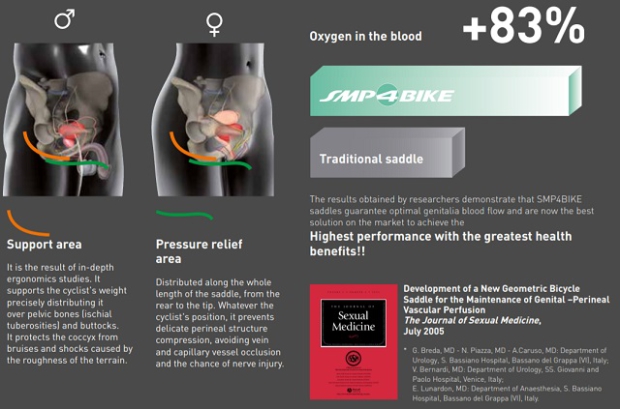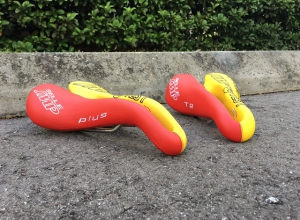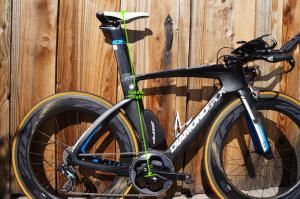We all know that saddles are highly individual, and many agree that they’re the most important part of the bike. If you’re like me, you’ve tried more than your fair share of them, on a quest for finding “the one”. In the past, I’ve made several steps in the right direction. There has been plenty of trial-and-error, but also fastidious measuring of saddles and bikes, and MANY test rides.
The one thing I know for sure is that when it comes to time trial, triathlon, or otherwise aerobar-laden bikes, traditional saddles do not work for me. What do I mean by traditional saddle? Something with a wide (ish) rear, narrow nose, and no cutout or other anatomic shaping. It’s what you picture when you think “bike seat” or “road bike seat”. When I lean forward on the aerobars, traditional seats just put too much pressure on my perineum. I only mention this to give you a sense of where I’m coming from, and perhaps to help you know if your preferences might align with mine. Some triathletes seem to do fine with a traditional road-type saddle, and I’m not here to talk you out of it – we just have a very different preference for bicycle seats.
What is the alternative to a traditional bicycle saddle? There are several options out there, which can best be described as some form of anatomical, cutout, or nose-less saddle. The earliest record of these I can find is the Hobson Easyseat, dating back to the early 1980’s. Others include Spiderflex, BiSaddle, ISM, The Comfort Seat, Cobb, Dash… but by now, most manufacturers have something along these lines.
Today, however, I’m going to be reviewing something from longest continuously-run bicycle saddle company in Italy (a hotbed of bike seat brands), Selle SMP.

It was news to me that SMP has been around for so long (they were founded in 1947). However, for much of that history, SMP produced traditional-style saddles – those without a cutout or any anatomical provisions. It wasn’t until 2004 that SMP officially reinvented and relaunched themselves, armed with 4 new patents and a radical new design.
Features
While their new saddles retain the same overall silhouette as a traditional seat, they have a very wide internal cutout and depression that runs the entire length of the seat. In addition, they have a unique nose section which they call the “Eagle Beak tip”.

Eagle Beak? I’ll translate that for you. Rather than remove the nose of the seat, they’ve just bent it out of the way. Why do such a thing? There is a problem that some noseless saddles have, which many folks don’t realize. If you cut off a few inches from the front of a traditional seat, you’d also be cutting the rails of the seat (which attach it to the bike). That would present quite a safety problem. Noseless saddles get around this by effectively moving the top of the seat forward relative to the rails, allowing the nose to be removed without affecting the rails. Translation: As far as your fit is concerned, this moves the entire seat further forward.
To get around this reality, most people need to use a seatpost with a high amount of setback, and also push the saddle back on the rails – often beyond the manufacturer’s own rail markings. I can’t tell you how many times I’ve helped people that haven’t made this correction for their noseless saddle, and they say that their seat feels too wide. It feels that way because they’ve pushed the seat forward, putting another part of the seat up in place of the nose (a part which is wider than a saddle nose). The problem is understandable, as most novice cyclists don’t even know that there are different amounts of seatpost setback (or what that even means), creating confusion and frustration at a real-world level.
SMP’s solution of bending the nose down avoids this situation entirely. You get a full-length rail, and my experience has shown that I can usually run whatever seatpost I’d like. If your fit coordinates are based on a traditional-style saddle, you don’t have to change anything – no calculations or math.

Cutout and Blood Flow Claims
What about that cutout shape? Compared to every other “cutout” seat I’ve tried, SMP has the widest cutout. It’s cavernous. For me it’s also very comfortable, and I experienced zero numbness or problems.
I’ll report on SMP’s official results, but note that SMP is very Italian, and there is a language barrier (I’d like to talk to their marketing department about their slogan “Designed On Your Body”…). I’ll venture a guess that this really translates to “Designed FOR Your Body”. I digress.
SMP quotes an 83% improvement of oxygen in the blood compared to traditional saddles. Elsewhere, they say that their saddles provide “full blood flow”, which their US representatives tell me translates to zero drop in genital blood flow when the rider is warmed up and riding at a normal pace. SMP saddles are also featured in the peer-reviewed Journal of Sexual Medicine, which concluded that SMP saddles were a (statistically significant) improvement over traditional saddles in terms of percentage of oxygen carried in the blood to the genitals. As with all manufacturer-provided data, I encourage you to take it with a grain of salt, and that we should all seek out as much independent, 3rd-party data as possible. For me, SMPs claims aligned with my experience, and I felt zero problems “down there”.

SMP Sizing
SMP has an interesting approach to recommending your saddle. They go by your pants size. I thought I’d seen everything under the sun for picking a saddle – sit bone width, flexibility tests, charts, graphs, and more. But after hearing SMP’s pitch on why they do it this way, I can’t say it’s worse than anything else out there.
The reason they go by pants size is that using sit bone width or other methods doesn’t take in to account your soft tissue. And by “soft tissue”, I don’t just mean your genitals, but ALL of your non-bony stuff. Muscle, fat, thighs, butt… and it also hints well at your actual body weight, too. The larger the pants size, the wider your saddle should be, according to SMP.

It’s not perfect. I tend to like wider saddles, and ended up on a saddle that was a size or two above their recommended range – go figure.
Padding is kept separate from width in their recommendations, which I think is a good idea. Padding preferences are all over the map, and it’s very hard to predict. Some people love firm, some soft, and some like it in-between. Personally, I prefer to err on the side of more padding.
Riding and Review
I had a chance to try out both the T1 and T2 triathlon saddles from SMP (plus a couple road cycling models, which we might cover separately). Note that SMP also sells a TT (time trial) series. These are identical to the T (triathlon) series. Do the roadies and triathletes have that much animosity… that they must change the name by one letter to satisfy each?
The naming system that SMP uses for their triathlon saddles is somewhat confusing, so I’ll do my best to clarify. They main saddles you should consider, from wide to narrow, are the T1 (164mm), T2 (156mm), and T5 (141mm). Note that these are maximum widths at the rear of the saddle, and all three saddles feature SMP’s widest center cutout. All have what I’d call a “medium-high” level of padding. It’s not super firm, not super soft, but has enough padding to be comfortable with triathlon shorts for most people.
They also have the T3 (133mm) and T4 (135mm, pictured below). I’m slightly less enthusiastic about these two models for most people, because they have a narrower center channel. However, if you have trouble with wide saddles in general and really like something narrow, the T3 and T4 could work for you.

Some of you might think that all of these saddles sound very wide, with some of the competition going as narrow as 110 or 120mm in maximum width. I’ll refer you to THIS article for full details, but I think that there is a lot of confusion and misunderstanding out there that has guided too many athletes to saddles with a narrow rear-end for triathlon purposes. With the right saddle and proper setup, having enough rear width to support your sit bones is a good thing, providing more surface area to support your weight (especially if you have tight hamstrings or poor forward hip rotation).
Indeed, one of the main reasons I wanted to try SMP is that I had been wanting to try something wider. All of my experience in the past several years has been on seats of 110 – 145mm in width. Many manufacturers have a LOT of offerings in the range of about 130 – 140mm. Over time, I found myself gravitating more and more towards the wide end of this spectrum, for the specific reason that it provides me with better support and less pressure on my pubic rami.
My results: The SMP T1 and T2 are the most comfortable triathlon saddles I’ve used to date. They’re simply fantastic, and have changed my expectation for what “comfortable” means on a triathlon bike. Of course – the caveats. I haven’t tried every saddle on earth. You’re different than me. I could always find something more comfortable later. That’s life, but for now I’m a very happy camper. Note that all rides were done on a steep seat tube angle triathlon bike.

The key to SMP’s comfort is their generous amount of shaping to the sides of the seat. They’re positively curvaceous. I felt zero sharp edges, and as a result had no bruising, soreness, chafing or saddle sores (all of which have plagued me to some degree with noseless saddles having a very flat side-to-side profile). SMP’s curves follow my body, giving lots of contact area and no pressure points. Combined with the large cutout and lack of any numbness, I found myself forgetting about the saddle entirely for long stretches of time. I even rode several times with no chamois cream at all – something I wouldn’t have dreamed about in the past. The result? Not a single saddle sore. I was truly shocked.
How do you choose the best one for you? The T2 is your bread and butter, if you want to try one SMP triathlon saddle. That’s where you start. It’s in the middle of the T1, T2, T5 range, and should give you an idea of what width will work for you. I have a preference for “wide-ish” saddles with a fair amount of padding. I personally lean towards the T1 as my favorite for a couple reasons. First, I’m not as competitive as I used to be. I ride a bit slower, I lift more weights and weigh more, and don’t pedal quite as hard. I value comfort first. If I was really getting back in to competition, I’d probably pick the T2. It provides a little bit more freedom of movement for my legs at the expense of some seating area.

Availability, Pricing, Final Details
If SMP has one problem in triathlon today, it’s popularity (or perhaps availability?). They distribute through Albabici in California, who sells to retail stores in the USA - some of whom have Demo saddles for you to try. I was told that they’re working on development of a larger direct-ship demo program, and for now you can contact Albabici directly to arrange a demo shipment.
All of the T-series and Pro series road saddles sell for an MSRP of $260, and feature stainless steel rails and handmade (in Italy!) construction. Weight for the T1 and T2 is 375 grams (stainless rail) or 320 grams (carbon rail). They also have a lower-end vacuum molded line for $160, but this unfortunately doesn’t yet include the triathlon products. I think for SMP to truly succeed in triathlon, a lower price point will be crucial.
I didn’t use a rear hydration system during my test, but SMP representatives tell me that the XLAB Super Wing (the version specific to SMP) and the Profile RML are their top recommendations.
Overall, I was quite surprised at how well I liked SMP saddles, since I just don’t see a ton of them out in the wild. They seem to be popular for road cycling, but triathletes haven’t yet gotten the memo – including me, an industry veteran. If you have trouble with saddle sores, numbness, or can’t seem to quite get comfortable on other noseless saddles, SMP should be on your radar.



